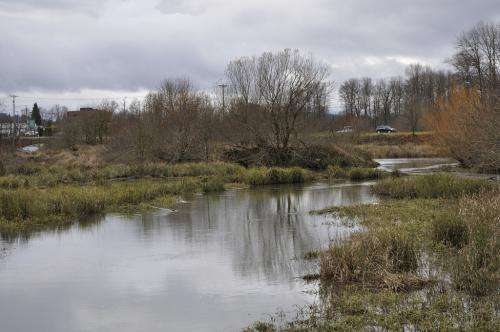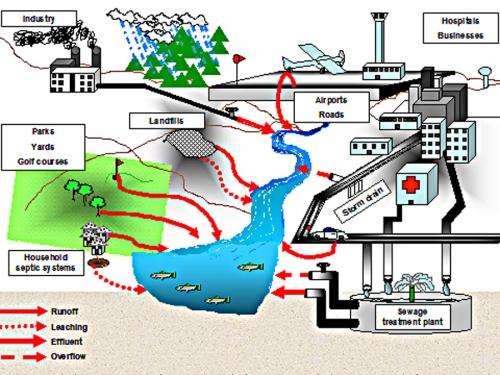Impact of urban areas on fish restoration

The restoration of salmon and steelhead habitat in the Pacific Northwest has focused largely on rural areas dominated by agricultural and forested lands, but researchers increasingly are looking at the impact of urban areas on the well-being of these fish.
Metropolitan areas – and even small towns – can have a major impact on the waterways carrying fish, researchers say, but many progressive cities are taking steps to mitigate these effects. The issues, policies and impacts of urban areas on salmon, steelhead and trout are the focus of a new book, "Wild Salmonids in the Urbanizing Pacific Northwest," published by Springer.
The influx of contaminants and toxic chemicals are two of the most obvious impacts, researchers say, but urban areas can heat rivers, alter stream flows and have a number of impacts, according to Carl Schreck, a professor of fisheries and wildlife at Oregon State University and a contributing author on the book.
"One of the biggest issues with cities and towns is that they have huge areas of compacted surfaces," Schreck pointed out. "Instead of gradually being absorbed into the water table where the ground can act as a sponge and a filter, precipitation is funneled directly into drains and then quickly finds its way into river systems.
"But urban areas can do something about it," Schreck added, "and Portland is very avant-garde. They've put in permeable substrate in many areas, they've used pavers instead of pavement, and the city boasts a number of rain gardens, roof eco-gardens and bioswales. When it comes to looking for positive ways to improve water conditions, Portland is one of the greenest cities in the world."
The origin of the "Wild Salmonids" book began in 1997, when the Oregon Legislature established the Independent Multidisciplinary Science Team (IMST) to address natural resource issues. In 2010, the group – co-chaired by Schreck – created a report for Oregon Gov. John Kitzhaber and the legislature that provided an in-depth look at the issues and policies affecting salmonid success in Oregon and the influence of urban areas. That report was so well-accepted by Oregon communities, the researchers wrote a book aimed at the public.
The new book, Wild Salmonids in the Urbanizing Pacific Northwest, is available from Springer at: bit.ly/J5Dn8x. Dozens of scientists contributed to the book, which was edited by Kathleen Maas-Hebner and Robert Hughes of OSU's Department of Fisheries and Wildlife, and Alan Yeakley of Portland State University, who was senior editor.

"One of the things we're trying to do is add the social dimension to the science," said Kathleen Maas-Hebner, a senior research scientist and one of the editors of the book. "The science is important, but the policies and the restoration efforts of communities are a huge part of improving conditions for fish."
Many Northwest residents are unaware of some of the everyday ways in which human activities can affect water quality and conditions, and thus fish survivability. Products from lawn fertilizers to shampoos eventually make their way into rivers and can trigger algal blooms. Even septic tanks can leach into the groundwater and contribute the byproducts of our lives.
"Fish can get caffeine, perfume and sunblock from our groundwater," Schreck said. "The water that flows from our cities has traces of birth control pills, radiation from medical practice, medical waste, deodorants and disinfectants. We could go on all day. Suffice it to say these things are not usually good for fish."
The most effective strategy to combat the problem may be to reduce the use of contaminants through education and awareness, and ban problematic ingredients, Maas-Hebner said.
"Phosphates, for example, are no longer used in laundry detergents," she said. "Fertilizer and pesticide users can reduce the amounts that get into rivers simply by following application instructions; many homeowners over-apply them."
Another hazard of urban areas is blocking fish passage through small, natural waterways. Many streams that once meandered are channeled into pipe-like waterways, and some culverts funnel water in ways that prevent fish from passing through, Schreck said.
"If the water velocity becomes too high, some fish simply can't or won't go through the culvert," said Schreck, who in 2007 received the Presidential Meritorious Rank Award from the White House for his fish research. "Some cities, including Salem, Ore., are beginning to use new and improved culverts to aid fish passage."
Other tactics can also help. Smaller communities, including Florence, Ore., offer incentives to developers for maintaining natural vegetation along waterways, the researchers say.
Despite the mitigation efforts of many Northwest cities and towns, urban hazards are increasing for fish. One of the biggest problems, according to researchers, is that no one knows what effects the increasing number of chemicals humans create may have on fish.
"There are literally thousands of new chemical compounds being produced every year and while we may know the singular effects of a few of them, many are unknown," Schreck said. "The mixture of these different compounds can result in a 'chemical cocktail' of contaminants that may have impacts beyond those that singular compounds may offer. We just don't know.
"The research is well behind the production of these new chemicals," Schreck added, "and that is a concern."
Provided by Oregon State University
















